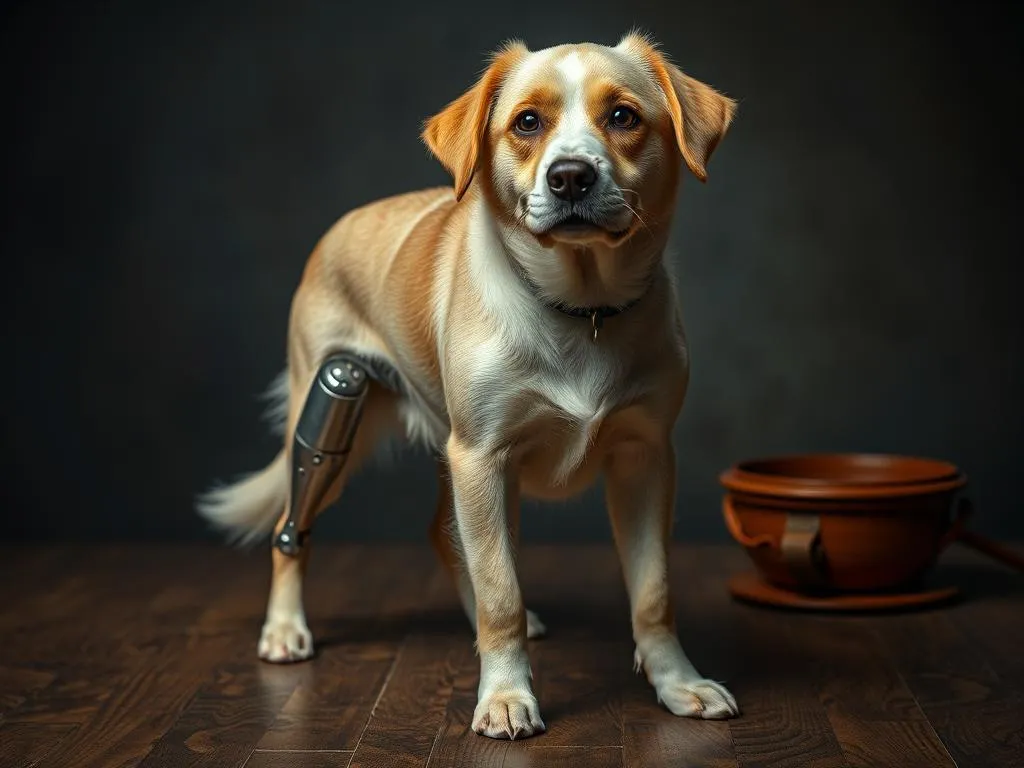
Introduction
Creating a prosthetic leg for a dog is a significant undertaking that can enhance the quality of life for furry friends who have lost a limb. A prosthetic leg serves as a substitution for a missing limb, allowing dogs to regain mobility and continue enjoying their lives. The importance of these devices cannot be overstated, as they provide dogs with the ability to run, play, and interact with their environment, which is essential for their overall wellbeing.
In this article, we will delve into the process of making a prosthetic leg for dogs, covering everything from understanding the need for a prosthetic to training your dog to use it effectively. Whether your dog has lost a limb due to injury, congenital disabilities, or medical conditions, this guide will provide you with the necessary steps to create a prosthetic leg that meets their needs.
Understanding the Need for a Prosthetic Leg
Common Reasons for Limb Loss in Dogs
Dogs may require a prosthetic leg for various reasons:
- Trauma: Accidents or injuries can lead to limb loss, often resulting from car accidents or severe falls.
- Congenital Disabilities: Some dogs are born with limb deformities that hinder their mobility.
- Medical Conditions: Illnesses such as cancer or infections can necessitate amputation, leading to the need for a prosthetic.
Signs That a Dog May Need a Prosthetic Leg
Recognizing the signs that your dog may need a prosthetic leg is crucial. Look out for:
- Difficulty Walking or Running: If your dog struggles to move around or seems to favor one leg, it may be time to consider a prosthetic.
- Signs of Pain or Discomfort: Lameness, whimpering, or reluctance to put weight on a limb can indicate that your dog is in pain.
- Decreased Mobility or Reluctance to Play: If your dog is less active than usual, it might be due to mobility issues stemming from limb loss.
Consultation with a Veterinarian
Importance of Professional Guidance
Before embarking on the journey to create a prosthetic leg for a dog, consulting with a veterinarian is essential. A vet can assess your dog’s condition and determine whether a prosthetic is a suitable option. They are trained to evaluate the dog’s overall health and mobility needs, ensuring that the prosthetic will be beneficial.
What to Expect During the Consultation
During your visit to the veterinarian, expect the following:
- Physical Examination: The vet will conduct a thorough examination of your dog to assess their condition and mobility.
- Diagnostic Imaging: Techniques such as X-rays or CT scans may be used to understand the extent of limb loss and the health of surrounding tissues.
- Discussion of Options: Your vet will discuss various options, including the possibility of surgery or a prosthetic leg, and help you make an informed decision.
Designing the Prosthetic Leg
Gathering Necessary Measurements
Accurate measurements are critical when designing a prosthetic leg for a dog. Here are the key areas to measure:
- Length: Measure from the top of the leg to the ground.
- Weight: Knowing your dog’s weight helps in choosing appropriate materials.
- Width: Measure the width of the leg at its base.
Materials Needed
The choice of materials will significantly affect the final product. Common materials include:
- Plastic: Lightweight and durable, making it a popular choice.
- Foam: Often used for padding, providing comfort for the dog.
- Metal: May be used for structural support, particularly in heavier designs.
Sourcing these materials can be done through local hardware stores or online suppliers that specialize in pet prosthetics.
Types of Prosthetic Designs
There are two main types of prosthetic designs to consider:
- Custom Prosthetics: Tailored specifically to your dog’s measurements and needs. They may take longer to create but often provide the best fit and comfort.
- Off-the-Shelf Prosthetics: These are pre-made and can be more affordable. However, they may not fit every dog perfectly.
Each option has its pros and cons, and discussing them with your vet can help you make the best choice.
Step-by-Step Guide to Making a Prosthetic Leg
Tools Needed
Before you start building the prosthetic leg, gather the following tools:
- Saw: For cutting materials.
- Glue: Strong adhesive for assembling parts.
- Screwdriver: For securing any metal components.
- Measuring Tape: For precise measurements.
Creating a Template
- Create a Template: Using the measurements gathered, create a template out of cardboard or stiff paper. This will serve as a guide for cutting your materials.
Cutting and Shaping the Materials
- Cutting the Materials: Carefully cut the plastic or foam according to your template. Ensure all pieces are smooth and fit together snugly.
Assembling the Prosthetic
- Assembling the Prosthetic: Start assembling the prosthetic by securing the pieces together with glue. Ensure joints are stable, and consider using screws for added reinforcement where necessary.
Fitting the Prosthetic on the Dog
- Fitting the Prosthetic: Once assembled, gently fit the prosthetic on your dog. Adjust it as needed for comfort, ensuring it does not rub or cause irritation.
Training Your Dog to Use the Prosthetic Leg
Importance of Gradual Introduction
Introducing a prosthetic leg to your dog should be a gradual process. It’s crucial to allow them time to adjust to the new device without overwhelming them.
Techniques for Training
- Positive Reinforcement: Use treats and praise to encourage your dog to use the prosthetic. Reward them when they take steps or show interest in the leg.
- Short Training Sessions: Keep training sessions brief to avoid tiring your dog out. Gradually increase the duration as they become more comfortable.
Monitoring Progress
Carefully monitor your dog’s progress as they adapt to the prosthetic leg. Look for signs of comfort, such as:
- Increased Mobility: Your dog should begin to walk and run more freely.
- Playfulness: A return to their playful nature is a good indicator that they are adjusting well.
Be vigilant for any signs of discomfort, such as limping or excessive licking at the prosthetic.
Maintenance and Care for the Prosthetic Leg
Regular Inspections
Regularly inspect the prosthetic leg for signs of wear and tear. Look for any cracks, loose joints, or areas that may irritate your dog.
Cleaning and Upkeep
Maintaining hygiene is essential. Clean the prosthetic leg regularly using mild soap and water. Ensure it dries thoroughly to prevent any moisture-related issues.
When to Seek Professional Help
If you notice any significant wear or if your dog seems uncomfortable, consult your veterinarian. They can assess whether adjustments or repairs are needed.
Success Stories and Case Studies
Real-Life Examples
Many dogs have successfully adapted to prosthetic legs, returning to their normal activities. For instance, a golden retriever named Max lost his leg after a severe injury. With a custom prosthetic, he was able to run and play again, bringing joy to his family.
Community Support and Resources
Online forums and support groups can be invaluable for dog owners navigating the journey of prosthetics. Engaging with others who have had similar experiences can provide encouragement and helpful tips.
Conclusion
Creating a prosthetic leg for a dog is a rewarding endeavor that can significantly improve their quality of life. From understanding the need for a prosthetic to the detailed steps of making and fitting one, dog owners can take proactive steps to help their furry friends regain mobility. Remember, patience and love are crucial throughout this process.
If you are considering this life-changing option for your dog, consult with professionals, gather the necessary materials, and don’t hesitate to share your journey with others in the community. Your efforts can lead to a happier, more active life for your beloved pet.









